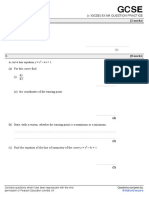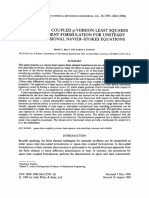Introduction To Dynamics
Uploaded by
Mark Joseph ValdezIntroduction To Dynamics
Uploaded by
Mark Joseph ValdezINTRODUCTION TO DYNAMICS
Mechanics is a branch of physical science concerned with the behavior of bodies subjected to
the action of forces. The mechanics of rigid bodies is divided into two areas: statics and dynamics.
Statics is the study of objects in equilibrium (objects either at rest or in uniform motion i.e. moving
in constant velocity). Dynamics is the study of objects with accelerated motion due to the effect of a
force.
Dynamics has two branches: kinematics and kinetics. Kinematics treats only the geometric aspects
of the motion. It is used to define the motion of a particle without considering the forces causing
the motion. Kinetics analyzes the forces causing the motion. It relates the force acting on a body to
its mass and acceleration.
KINEMATICS OF PARTICLES
Terms:
particle – denotes an object of point size; a body so small that any differences in the motion of
its parts can be neglected (e.g. molecule, atom, electron)
body – denotes a system of particles which form an object of appreciable size
A. RECTILINEAR MOTION OF PARTICLES
Rectilinear Kinematics (Rectilinear Motion) – refers to a particle moving along a straight line. It is said
to be in rectilinear motion if any two particles of a body travel the same distance along two parallel
straight lines
Uniform Motion in a Straight Line
Concept Definition Symbol Equation
Displacement vector distance from an origin 𝛥𝑠 𝛥𝑠 = 𝑠’ − 𝑠
Velocity time rate of change of displacement vave 𝑣𝑎𝑣𝑒 =
∆𝑠
∆𝑡
speed – magnitude of velocity v
Acceleration time rate of change of velocity 𝑎 ∆𝑣
𝑎=
∆𝑡
MOTION OF A PARTICLE
Uniform Rectilinear Motion (Uniform Motion) – motion with constant velocity
𝑠=𝑣◦𝑡
Uniformly Accelerated Rectilinear – motion with constant acceleration
*for constant acceleration, ac, initial velocity is equal to the final velocity
a. speed as a function of time
𝑣𝑓 = 𝑣𝑖 + 𝑎𝑐 𝑡
ES2: Dynamics of Rigid Bodies | engrjco 1
b. position as a function of time
1
𝑠𝑓 − 𝑠𝑖 + 𝑣𝑖 𝑡 + 𝑎𝑐 𝑡 2
2
c. speed as a function of position
𝑣𝑓 2 = 𝑣𝑖 2 + 2𝑎𝑐 (𝑠𝑓 − 𝑠𝑖 )
𝒈 = 𝟗. 𝟖𝟏 𝒎/𝒔𝟐 𝒐𝒓 𝟑𝟐. 𝟑𝟐 𝒇𝒕/𝒔𝟐
Free-Falling Object
• an object is falling freely with no forces acting upon it except gravity
MOTION OF SEVERAL PARTICLES
Relative Motion
For particles moving along the same line, time should be recorded from the same starting
instant, and displacements should be measured from the same origin in the same direction.
• 𝑥𝐵/𝐴 = 𝑥𝐵 − 𝑥𝐴 = relative position of B with respect to A
𝑥𝐵 = 𝑥𝐴 + 𝑥𝐵/𝐴
• 𝑣𝐵/𝐴 = 𝑣𝐵 − 𝑣𝐴 = relative velocity of B with respect to A
𝑣𝐵 = 𝑣𝐴 + 𝑣𝐵/𝐴
• 𝑎𝐵/𝐴 = 𝑎𝐵 − 𝑎𝐴 = relative acceleration of B with respect to A
𝑎𝐵 = 𝑎𝐴 + 𝑎𝐵/𝐴
ILLUSTRATIVE PROBLEMS
1. A ball is tossed from the window 20 meters above the
ground with a vertical velocity of 10 m/s. Determine:
a) velocity and elevation above the ground at time t
b) highest elevation reached by ball and corresponding
time
c) time when the ball hit the ground and corresponding
velocity
2. Ball is thrown vertically 12 m level in elevator shaft with
initial velocity of 18 m/s. At same instant, open-platform
elevator passes 5 m level moving upward at 2 m/s.
Determine:
a) when and where ball hits elevator
b) relative velocity of ball and elevator at contact
ES2: Dynamics of Rigid Bodies | engrjco 2
You might also like
- Chapter 2 - Describing Motion (Notes) (PHYSICS IGCSE)100% (1)Chapter 2 - Describing Motion (Notes) (PHYSICS IGCSE)8 pages
- ME 101-Lecture 22-25-Kinematics of A ParticleNo ratings yetME 101-Lecture 22-25-Kinematics of A Particle66 pages
- Kinematics of Particles: - IntroductionNo ratings yetKinematics of Particles: - Introduction38 pages
- Introduction To Dynamics of Rigid BodiesNo ratings yetIntroduction To Dynamics of Rigid Bodies12 pages
- ME 101-Lecture 22-25-Kinematics of A Particle PDFNo ratings yetME 101-Lecture 22-25-Kinematics of A Particle PDF67 pages
- Dynamics: Introduction To Dynamics Kinematics of A ParticleNo ratings yetDynamics: Introduction To Dynamics Kinematics of A Particle55 pages
- Kinematics of Particles: Study Guide For Module No. 2No ratings yetKinematics of Particles: Study Guide For Module No. 28 pages
- Isu Module Subject: CE 223 and Dynamics of Rigid BodiesNo ratings yetIsu Module Subject: CE 223 and Dynamics of Rigid Bodies17 pages
- WEEK2 - Lesson 3 - Uniform Rectilinear Motion and Uniformly Accelerated Rectilinear MotionNo ratings yetWEEK2 - Lesson 3 - Uniform Rectilinear Motion and Uniformly Accelerated Rectilinear Motion18 pages
- Lecture 102 Particle-Rectilinear Motion (Kinematics)No ratings yetLecture 102 Particle-Rectilinear Motion (Kinematics)5 pages
- MECH 2 MODULE 1 Dynamics of Rigid BodiesNo ratings yetMECH 2 MODULE 1 Dynamics of Rigid Bodies29 pages
- Chapter 12 - Kinematics of a Particle (Edisi 12) Sd Rectangular ComponentsNo ratings yetChapter 12 - Kinematics of a Particle (Edisi 12) Sd Rectangular Components93 pages
- Engineering Mechanics Vol II Dynamics Sixth Edition Chapter2No ratings yetEngineering Mechanics Vol II Dynamics Sixth Edition Chapter298 pages
- Dynamics of Rigid Bodies: Miko Anderson P. YjaresNo ratings yetDynamics of Rigid Bodies: Miko Anderson P. Yjares50 pages
- Position_Velocity_and_Acceleration_cctoNo ratings yetPosition_Velocity_and_Acceleration_ccto17 pages
- ENS 162 Lecture 1 Kinematics of ParticlesNo ratings yetENS 162 Lecture 1 Kinematics of Particles32 pages
- (International Library of Sociology) Peter Merriman - Mobility, Space and Culture-Routledge (2012)No ratings yet(International Library of Sociology) Peter Merriman - Mobility, Space and Culture-Routledge (2012)225 pages
- Physics Worksheet Lesson 4 Linear Motion-6No ratings yetPhysics Worksheet Lesson 4 Linear Motion-61 page
- Hints For Solving Relativity Problems: Reference FramesNo ratings yetHints For Solving Relativity Problems: Reference Frames13 pages
- Centroids, Centre of Mass & Centres of GravityNo ratings yetCentroids, Centre of Mass & Centres of Gravity42 pages
- A Space-Time Coupled P-Version Least Squares Finite Element Formulation For Unsteady Two-Dimensional Navier-Stokes EquationsNo ratings yetA Space-Time Coupled P-Version Least Squares Finite Element Formulation For Unsteady Two-Dimensional Navier-Stokes Equations26 pages
- Theory of Relativity Ariny Amos Astronomer Author NOVELNo ratings yetTheory of Relativity Ariny Amos Astronomer Author NOVEL511 pages
- Acceleration Velocity and Position Graphs WorksheetNo ratings yetAcceleration Velocity and Position Graphs Worksheet4 pages
- Wave Propagation: Odd Is Better, But Three Is BestNo ratings yetWave Propagation: Odd Is Better, But Three Is Best8 pages
- A Consistent World Model For Consciousness and PhysicsNo ratings yetA Consistent World Model For Consciousness and Physics12 pages
- Birla Institute of Technology & Science, PilaniNo ratings yetBirla Institute of Technology & Science, Pilani1 page
- Chapter 3 (1 Year Physics) Motion and Force50% (4)Chapter 3 (1 Year Physics) Motion and Force15 pages

























































































